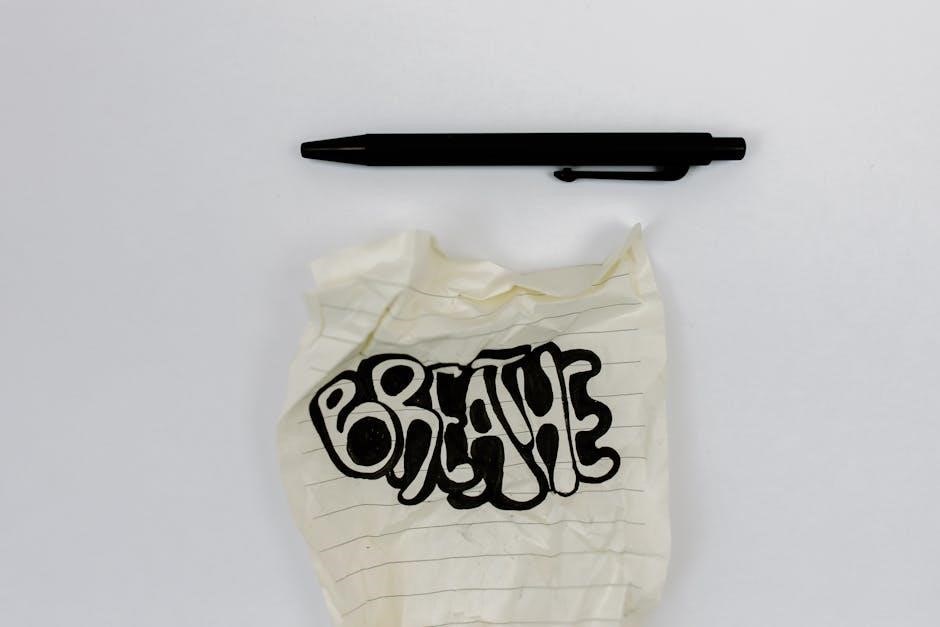
This theme explores the interconnectedness of thoughts, words, and deeds, emphasizing their impact on individuals and communities. It promotes self-awareness, empathy, and ethical behavior, fostering a positive school environment.
1.1 Understanding the Interconnectedness
The foundation of this theme lies in recognizing how thoughts, words, and deeds are deeply intertwined. A single thought can shape words, which in turn inspire actions, creating a ripple effect. This cycle highlights the power of internal beliefs influencing external behaviors, emphasizing the importance of mindful thinking. By understanding this connection, students can better navigate their choices, fostering empathy and responsibility. This awareness encourages intentional communication and ethical decision-making, laying the groundwork for positive personal and societal outcomes.
1.2 Importance in School Settings
The integration of thoughts, words, and deeds in schools fosters a supportive environment, promoting empathy and responsible behavior. It encourages students to reflect on their actions, develop self-awareness, and understand the impact of their choices. This theme helps create a culture of kindness, respect, and accountability, essential for positive social interactions. By addressing these elements, schools empower students to navigate challenges thoughtfully, communicate effectively, and contribute to a harmonious community, laying a strong foundation for ethical growth and lifelong learning.

The Core Concepts of Thoughts, Words, and Deeds
This section introduces the fundamental principles of thoughts, words, and deeds, highlighting their interconnectedness and the importance of unity in shaping positive interactions and ethical, responsible choices.
2.1 Unity in Thoughts, Words, and Deeds
Unity in thoughts, words, and deeds signifies harmony and consistency in one’s beliefs, expressions, and actions. It fosters authenticity, integrity, and ethical behavior, creating a balanced and purposeful life. This unity teaches individuals to align their internal beliefs with external expressions, promoting trustworthiness and moral strength. By practicing this alignment, students develop self-awareness and responsibility, becoming role models for others. This concept emphasizes the importance of matching intentions with outcomes, ensuring that actions reflect true values and principles.
2.2 The Cycle of Influence: Thoughts to Words to Actions
The cycle of influence begins with thoughts, which shape words, and ultimately lead to actions. This continuous process highlights how internal beliefs and ideas manifest into external behaviors. Positive thoughts foster kind words and compassionate actions, creating a ripple effect of goodness. Conversely, negative thoughts can lead to harmful words and hurtful actions. Understanding this cycle encourages mindfulness and intentionality, empowering individuals to choose thoughts that inspire positive outcomes and contribute to a harmonious community.
2.3 The Power of Language and Communication
Language and communication hold immense power, shaping interactions and relationships. Positive words uplift and inspire, fostering connection and understanding. Conversely, harmful language can cause pain and division. Mindful communication encourages empathy, active listening, and clarity. By choosing words wisely, individuals can build trust, resolve conflicts, and create a supportive environment. This theme emphasizes the responsibility to use language intentionally, promoting kindness and respect in all interactions, and fostering a culture of inclusivity and compassion.

The Impact of Positive and Negative Actions
Positive actions inspire and uplift, fostering connection and well-being. Negative actions can harm and divide, causing lasting effects. Understanding these impacts guides responsible decision-making and ethical behavior.
3.1 Consequences of Positive Thoughts, Words, and Deeds
Positive thoughts, words, and deeds foster a supportive environment, enhancing self-esteem and empathy. They inspire kindness, improve relationships, and create a culture of gratitude and respect. Students learn that uplifting actions lead to personal and collective well-being, encouraging a sense of community and responsibility. This mindset helps build resilience and promotes a positive social climate, where everyone feels valued and connected.

3.2 Effects of Negative Thoughts, Words, and Deeds
Negative thoughts, words, and deeds can cause harm, leading to emotional distress, damaged relationships, and a toxic environment. They often result in conflict, mistrust, and division, fostering fear and resentment. Such actions can create cycles of negativity, undermining self-esteem and collective well-being. Over time, they may lead to long-term emotional scars and social isolation. Recognizing these consequences is crucial for promoting understanding and encouraging positive change in individuals and communities. Addressing negative patterns helps build a more supportive and harmonious environment.

Curriculum Integration Across Subjects
The theme is integrated across subjects, fostering holistic learning. Language arts analyzes literature, history examines decisions, science explores impacts, and math solves ethical problems, promoting unity of concepts.
4.1 Language Arts: Analyzing Literature
Language arts integrates the theme by analyzing literature that explores the impact of thoughts, words, and deeds on characters and plot development. Students examine how characters’ internal beliefs shape their dialogue and actions, influencing outcomes. Texts are chosen to highlight moral dilemmas, ethical choices, and the consequences of decisions. Through discussions, essays, and creative writing, students connect literary themes to real-life scenarios, fostering critical thinking and empathy. This approach encourages students to reflect on how literature mirrors the interconnectedness of human behavior and communication.
4.2 History: Studying Historical Decisions
History classes explore how historical figures’ thoughts, words, and deeds shaped events and societies. Students analyze decisions, motivations, and their consequences, connecting past actions to present impacts. Case studies of leaders like Martin Luther King Jr. or Gandhi highlight how aligned thoughts and deeds inspired change. Discussions focus on ethical dilemmas, encouraging students to reflect on the responsibility of historical figures and the power of intentional actions. This fosters critical thinking about causality and the legacy of choices.
4.3 Science: Environmental and Health Impacts
Science lessons integrate the theme by examining how thoughts, words, and deeds affect the environment and health. Students explore the consequences of environmental actions, such as conservation efforts or pollution, linking decisions to their impact on ecosystems. Discussions on health emphasize how positive thoughts and words promote well-being, while harmful choices lead to negative outcomes. Hands-on activities, like sustainability projects, encourage students to make ethical decisions, fostering a sense of responsibility for their actions and their effects on the world.
4.4 Mathematics: Ethical Problem-Solving
Mathematics integrates ethical decision-making by presenting problems that require logical reasoning and moral consideration. Students analyze real-world scenarios, such as resource allocation or financial decisions, to understand the consequences of their choices. Activities encourage critical thinking about fairness, equality, and sustainability, fostering ethical problem-solving skills. By connecting numbers to real-life dilemmas, students learn to approach mathematical challenges with a sense of responsibility, preparing them to make informed, compassionate decisions in their future endeavors.
4.5 Art: Expressing Emotions Creatively
Art provides a platform for students to creatively express their emotions and thoughts through various mediums like painting, drawing, and sculpture. This allows them to visually communicate feelings and ideas, bridging the gap between internal reflections and external expressions. By exploring colors, textures, and compositions, students can convey complex emotions in a non-verbal yet powerful way. Such activities foster self-expression, creativity, and empathy, enabling students to connect with their inner world while understanding others’ perspectives, ultimately enhancing their emotional intelligence and confidence.
4.6 Physical Education: Sportsmanship
Physical education emphasizes sportsmanship, teaching students to align their thoughts, words, and deeds. Teamwork fosters respect and responsibility, while activities like reflective discussions after games encourage empathy. Students learn that positive encouragement and fair play reflect their values, promoting a supportive environment. This integration helps students understand how their actions impact others, reinforcing ethical behavior and positive interactions in all areas of life.

Lesson Planning Models
A five-step framework, inspired by J. Friedrich Herbert, includes preparation, engaging presentation, association with prior learning, generalization, and application through activities, ensuring a cohesive learning experience.
5;1 Five-Step Lesson Planning Framework
This structured approach ensures effective teaching of the theme. First, prepare thoroughly by gathering resources and anticipating student needs. Next, present concepts engagingly using visuals and real-life examples. Associate new knowledge with prior learning to enhance relevance. Generalize by applying principles to various scenarios, fostering critical thinking. Finally, allow practical application through activities like role-playing or debates, ensuring meaningful learning and retention. This framework creates a comprehensive and engaging experience.

Classroom Activities for Engagement
Engaging activities like role-playing, creative writing, and emotion recognition help students explore the theme. These exercises foster self-awareness, empathy, and ethical decision-making in a supportive environment.
6.1 Role-Playing Scenarios
Role-playing scenarios create a safe space for students to explore the impact of their thoughts, words, and deeds. These activities simulate real-life situations, such as conflict resolution or peer interactions, allowing students to practice constructive communication and empathy. By acting out different roles, students gain insight into how their choices affect others and learn to align their actions with positive values. This experiential learning fosters self-awareness, ethical decision-making, and responsible behavior, helping students connect their internal beliefs with external expressions.
6.2 Creative Writing Exercises
Creative writing exercises empower students to articulate their thoughts, words, and deeds through reflective and imaginative expression. Activities such as journaling, poetry, or short stories encourage students to explore their emotions and decisions. Writing prompts guide students to analyze the consequences of their actions and the impact of their words. These exercises foster self-reflection, empathy, and ethical reasoning, helping students connect their internal beliefs with external expressions. This creative process cultivates a deeper understanding of personal responsibility and integrity, aligning with the theme’s core principles.
6.3 Emotion Recognition Activities
Emotion recognition activities help students identify and understand their feelings, linking them to thoughts, words, and deeds. Using tools like feelings charts or flashcards, students explore emotions and their physical sensations. Role-playing scenarios simulate real-life situations, teaching constructive emotional expression. Creative writing exercises, such as journals or poems, allow students to reflect on their emotional experiences. Group discussions foster empathy and understanding of diverse emotional responses. These activities connect emotions to actions, promoting self-awareness and ethical decision-making, essential for responsible communication and behavior.

Empowering Students Through the Theme
This theme fosters self-awareness, encouraging students to align their thoughts, words, and deeds with ethical values, promoting responsible communication and decision-making for a positive impact.
7.1 Fostering Self-Awareness
Fostering self-awareness helps students understand the connection between their thoughts, words, and deeds. Through reflection exercises, students identify their values and emotions, gaining insight into how their choices impact themselves and others. This awareness encourages personal growth, enabling students to align their actions with ethical principles. By recognizing the power of their internal dialogue, students develop the ability to make intentional decisions, leading to more thoughtful and compassionate behavior in daily interactions.
7.2 Encouraging Responsible Communication
Responsible communication is vital for building positive relationships. By teaching students to express their thoughts and words thoughtfully, they learn to consider the impact of their communication. Role-playing scenarios and group discussions encourage active listening and empathy. This fosters an environment where students can articulate their feelings respectfully and resolve conflicts constructively. Emphasizing the power of language helps students understand how their words and actions can uplift or harm others, promoting a culture of kindness and inclusivity in both physical and digital spaces.
7.3 Promoting Ethical Decision-Making
Ethical decision-making is cultivated by helping students connect their thoughts and words to the consequences of their deeds. Through case studies and role-playing, students analyze moral dilemmas, considering multiple perspectives. Activities encourage empathy, critical thinking, and problem-solving, empowering students to make choices that align with their values. Service-learning projects further reinforce the impact of ethical actions, teaching students to act responsibly and contribute positively to their communities. This fosters a mindset of integrity and compassion in all aspects of life.

Global Perspectives and Community Engagement
This theme encourages students to explore global issues and engage in community service, fostering cultural awareness and social responsibility. Service-learning projects highlight the impact of thoughts, words, and deeds in diverse contexts, promoting ethical citizenship and unity worldwide.
8.1 Service-Learning Projects
Service-learning projects integrate community service with academic learning, allowing students to apply the thoughts, words, and deeds theme in real-world contexts. These projects focus on addressing social and environmental issues, fostering empathy and social responsibility. By engaging in activities like volunteering or environmental cleanups, students witness the tangible impact of their actions. This experiential learning enhances their understanding of global challenges and encourages them to become active contributors to positive social change, aligning their thoughts with meaningful deeds.
8.2 Cultural and Social Implications
The thoughts, words, and deeds theme highlights cultural and social implications, emphasizing how diverse norms shape communication and behavior. Across cultures, the expression of thoughts and words may vary, influencing actions and social dynamics. Understanding these differences fosters inclusivity and respect. By exploring cultural contexts, students learn to navigate diverse social landscapes thoughtfully, promoting cross-cultural understanding and harmonious interactions. This awareness encourages students to adapt their communication and actions to align with cultural sensitivity and global citizenship.